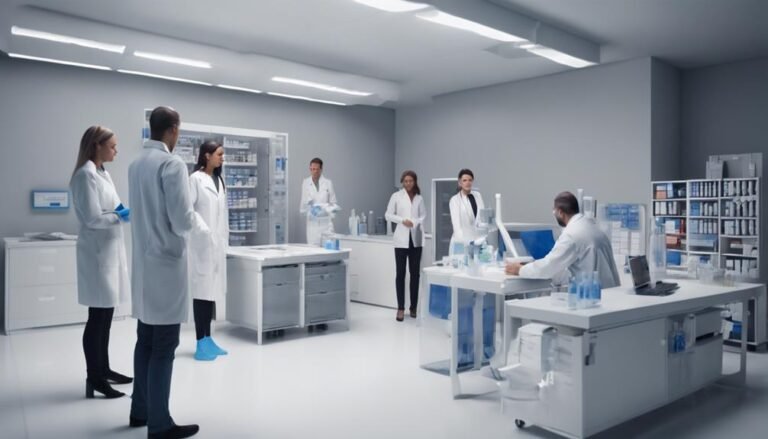Advanced Diagnostic Imaging Review: Clarity or Complexity?
In the world of advanced diagnostic imaging, the interplay between clarity and complexity is vital. Cutting-edge technologies offer precise insights, but mastering their interpretation is a continuous learning process for healthcare professionals. These advancements enhance accuracy in diagnosis and tailored treatment plans, elevating patient care. Patient comfort and cost-effectiveness are also pivotal considerations in this domain. Understanding the intricate balance between clarity and complexity is essential for optimizing healthcare delivery. For a deeper understanding of how these factors shape modern medical practices, explore further insights into the evolving landscape of diagnostic imaging.
Key Takeaways
- Technological advancements enhance clarity in diagnosis and treatment planning.
- Specialized software aids in interpreting complex imaging data for clearer insights.
- Multidisciplinary collaboration ensures comprehensive assessment and clearer treatment decisions.
- Timely reporting of imaging results promotes clarity in medical decision-making.
- Integration of advanced imaging tools streamlines processes for clearer outcomes.
Evolution of Imaging Technologies
Over the past few decades, diagnostic imaging technologies have advanced rapidly, revolutionizing the field of medical imaging. The evolutionary advancements in imaging technologies have been marked by significant technological breakthroughs that have transformed the way healthcare professionals diagnose and treat patients.
One of the key evolutionary advancements in imaging technologies is the shift from traditional x-ray imaging to more advanced modalities such as magnetic resonance imaging (MRI) and computed tomography (CT) scans. These technologies provide detailed cross-sectional images of the body, allowing for more accurate and thorough diagnoses. Additionally, the development of ultrasound technology has enabled non-invasive imaging of soft tissues and organs, reducing the need for exploratory surgeries.
Technological breakthroughs such as the introduction of digital imaging have also played an important role in improving the efficiency and accuracy of diagnostics. Digital imaging allows for the immediate viewing and sharing of high-quality images, leading to quicker treatment decisions and better patient outcomes. As imaging technologies continue to evolve, we can expect further enhancements that will shape the future of medical imaging.
Enhanced Diagnostic Accuracy
The evolution of imaging technologies has greatly contributed to the enhanced diagnostic accuracy in the field of medical imaging. When it comes to diagnostic precision, the advancements in imaging technologies have allowed for clearer and more detailed images, aiding healthcare professionals in identifying even the most subtle abnormalities. However, along with these improvements come interpretive challenges, as the increased complexity of the images may require specialized training to accurately analyze them.
- Technological Advancements: From higher resolution scans to 3D imaging capabilities, technological advancements have revolutionized the way medical conditions are diagnosed.
- Clinical Implications: The improved accuracy in diagnostics leads to better patient outcomes, as conditions can be detected earlier and more precisely diagnosed.
- Training Requirements: Healthcare professionals now need to undergo continuous training to keep up with the latest imaging technologies and interpretive techniques.
- Specialized Software: The development of specialized software programs aids in the interpretation of complex imaging data, enhancing diagnostic accuracy.
- Interdisciplinary Collaboration: With enhanced diagnostic accuracy, there's a growing need for interdisciplinary collaboration between imaging specialists and other healthcare professionals to ensure thorough patient care.
Impact on Treatment Planning
With the advancements in diagnostic imaging technologies, treatment planning in medical practice has been greatly influenced by the ability to visualize and understand the intricacies of patients' conditions with greater clarity and precision. The impact evaluation of these advanced imaging techniques on treatment planning is substantial. By providing detailed and accurate information about the patient's internal structures and potential abnormalities, imaging studies enable healthcare providers to create more tailored and effective treatment plans.
The ability to visualize the extent and nature of a condition through advanced imaging techniques allows for a more precise appraisal of treatment options. This precision leads to improved treatment outcomes as healthcare professionals can choose the most suitable interventions based on the specific characteristics of the patient's condition.
Furthermore, the use of diagnostic imaging in treatment planning enhances the overall quality of care by reducing the likelihood of unnecessary procedures or treatments. By precisely analyzing the condition through imaging, healthcare providers can minimize the risks associated with trial-and-error approaches, ultimately leading to better treatment outcomes for patients.
Patient Experience and Comfort
When considering patient experience and comfort during imaging procedures, it's essential to create a comfortable environment that minimizes anxiety.
Enhancing the overall experience involves attention to details such as room temperature, lighting, and communication with the patient.
These factors play a vital role in ensuring a positive imaging experience and maintaining patient comfort throughout the process.
Comfortable Imaging Environment
Enhancing the patient experience and promoting comfort during diagnostic imaging procedures is essential for guaranteeing excellent outcomes. To create a comfortable imaging environment, consider implementing the following:
- Ambient Lighting: Soft, adjustable lighting can help create a calming atmosphere.
- Soundproofing: Minimize external noise to reduce distractions and promote relaxation.
- Ergonomic Furniture: Comfortable seating or positioning aids can improve patient comfort during longer procedures.
- Relaxation Techniques: Offer options like guided imagery or music to help patients relax during imaging.
- Temperature Control: Maintain a comfortable temperature to make sure patients aren't too hot or cold during the procedure.
Minimizing Patient Anxiety
To minimize patient anxiety and enhance their overall comfort during diagnostic imaging procedures, consider implementing specific strategies designed to promote a sense of calm and relaxation. Patient support plays an essential role in alleviating anxiety. Encourage open communication by explaining the procedure in simple terms, addressing any concerns they may have, and actively listening to their questions. Providing clear instructions beforehand can help patients feel more prepared and informed, reducing uncertainty and fear.
Creating a welcoming environment through small gestures like offering blankets or adjusting room temperature can make a significant difference in patient comfort. Additionally, ensuring that the imaging equipment is as comfortable and non-threatening as possible can help ease anxiety levels. Some facilities offer relaxation techniques such as guided imagery or soothing music to help patients relax during the procedure.
Enhancing Overall Experience
Consider implementing personalized care strategies to enhance patient experience and comfort during diagnostic imaging procedures. To achieve this, focus on improved communication and streamlined processes. Enhancing the overall experience involves attention to detail and a patient-centric approach. Here are five key strategies to improve patient comfort and satisfaction:
- Provide Clear Instructions: Guarantee patients understand the procedure, what to expect, and how to prepare beforehand.
- Offer Comfortable Attire: Supply patients with appropriate garments to wear during the imaging process for comfort and modesty.
- Create a Relaxing Environment: Design waiting areas and imaging rooms to promote relaxation and reduce anxiety.
- Engage with Empathy: Train staff to communicate with compassion, actively listen to patients' concerns, and address them promptly.
- Follow Up and Follow Through: Maintain contact with patients post-procedure, provide results promptly, and offer support or further guidance as needed.
Cost-Effectiveness and Accessibility
Examining the cost-effectiveness and accessibility of diagnostic imaging services can provide valuable insights into improving healthcare delivery. When considering cost efficiency, it is essential to analyze the balance between the quality of imaging services and the expenses incurred. Equitable access guarantees that all individuals have the opportunity to benefit from diagnostic imaging regardless of their socioeconomic status or geographic location.
| Aspect | Description | Importance |
|---|---|---|
| Cost Efficiency | Evaluating the cost-effectiveness of diagnostic imaging procedures is vital in optimizing healthcare expenditures. | High |
| Equitable Access | Ensuring that diagnostic imaging services are available to all patients, irrespective of their background, promotes fair and just healthcare delivery. | High |
| Technological Advancements | Incorporating cutting-edge technology in diagnostic imaging can enhance accuracy and efficiency in diagnosis and treatment planning. | Medium |
| Timely Reporting | Efficient reporting and communication of imaging results are essential for prompt medical decision-making and patient care. | Medium |
Integration With Multidisciplinary Care
Integrating diagnostic imaging services with multidisciplinary care teams enhances collaboration and treatment outcomes in healthcare settings. This integration fosters a seamless flow of information and expertise among healthcare professionals, ultimately benefiting patient care. Through effective care coordination and communication, the multidisciplinary approach guarantees that all team members are aligned in providing the best possible care for patients.
Here are five key aspects to ponder when integrating diagnostic imaging with multidisciplinary care:
- Enhanced Communication: Facilitate open and clear communication channels among team members to guarantee timely information sharing.
- Improved Care Coordination: Streamline processes to ensure a coordinated approach to patient care, incorporating diagnostic imaging results effectively.
- Team Collaboration: Encourage a collaborative environment where healthcare professionals work together to develop thorough treatment plans.
- Shared Decision-Making: Involve all team members in decision-making processes, leveraging their diverse expertise for better outcomes.
- Continual Education: Provide ongoing education and training opportunities to keep the multidisciplinary team updated on the latest imaging technologies and practices.
Training and Skill Development
To guarantee peak performance within multidisciplinary care teams, a focus on training and skill development is paramount in enhancing the delivery of diagnostic imaging services. Skill enhancement is essential in ensuring that imaging professionals can accurately interpret results and provide high-quality patient care. Hands-on training plays a crucial role in honing these skills, allowing practitioners to familiarize themselves with the latest imaging technologies and techniques.
Effective skill development programs should encompass a combination of theoretical knowledge and practical experience. By offering hands-on training opportunities, professionals can refine their abilities to operate imaging equipment, analyze images accurately, and communicate findings effectively within the care team.
Continuous training and skill enhancement are vital in a field as rapidly evolving as diagnostic imaging. Staying current with advancements in technology and methodology through ongoing education ensures that imaging professionals can adapt to changes and deliver optimal care to patients. By investing in comprehensive training programs that prioritize hands-on experience, healthcare institutions can elevate the expertise of their imaging teams and improve overall service delivery.
Ethical Considerations in Imaging
Examine the ethical implications that guide decision-making in diagnostic imaging practices to uphold patient welfare and professional integrity. Ethical dilemmas frequently arise in imaging, necessitating thoughtful analysis to navigate complex situations. Patient autonomy plays a central role in these ethical considerations, as individuals have the right to make informed choices about their care.
Here are five key points to contemplate in addressing ethical issues within the field of diagnostic imaging:
- Informed Consent: Ensuring patients understand the risks and benefits of imaging procedures.
- Confidentiality: Safeguarding patient information and upholding their privacy rights.
- Conflict of Interest: Managing situations where personal interests may interfere with patient care.
- Resource Allocation: Balancing the need for imaging services with limited resources.
- End-of-Life Decisions: Handling imaging requests in palliative care or end-of-life scenarios with sensitivity and respect for patient wishes.
Regulatory Challenges and Compliance
Mastering regulatory challenges in diagnostic imaging demands a thorough grasp of compliance standards and guidelines to guarantee the delivery of quality patient care. Compliance challenges in diagnostic imaging can be multifaceted, ranging from ensuring proper documentation and reporting to adhering to safety protocols and legal requirements. Regulatory obstacles often include maneuvering through complex reimbursement policies, staying up-to-date with changing regulations, and implementing quality assurance measures to meet accreditation standards.
To tackle compliance challenges effectively, it's essential to establish robust protocols and procedures within imaging facilities. This involves conducting regular audits, providing in-depth staff training on regulatory requirements, and fostering a culture of compliance and accountability. By addressing regulatory obstacles proactively, imaging centers can enhance patient safety, optimize operational efficiency, and mitigate legal risks.
Future Trends in Diagnostic Imaging
Embracing emerging technologies is pivotal for staying at the forefront of advancements in diagnostic imaging. In the rapidly evolving landscape of medical imaging, several future trends are set to redefine the industry:
- Artificial Intelligence: The integration of AI algorithms into imaging systems will enhance diagnostic accuracy and streamline workflow.
- Automation Integration: Automating routine tasks such as image analysis and report generation will increase efficiency and reduce human error.
- Virtual Reality: Utilizing VR technology for training purposes and pre-surgical planning will revolutionize medical education and patient care.
- Immersive Experiences: Creating immersive experiences through augmented reality will provide clinicians with interactive tools for better visualization and diagnosis.
- Data Analytics: Leveraging big data analytics will enable healthcare providers to extract valuable insights from imaging datasets, leading to personalized treatment plans and improved patient outcomes.
Conclusion
To sum up, advanced diagnostic imaging technologies offer unparalleled clarity in diagnosing and treating medical conditions.
While some may argue that these technologies create complexity and challenges in healthcare delivery, it's essential to acknowledge the significant benefits they provide in improving patient outcomes and enhancing overall healthcare quality.
Embracing the advancements in diagnostic imaging will ultimately lead to better patient care and more efficient healthcare practices.






